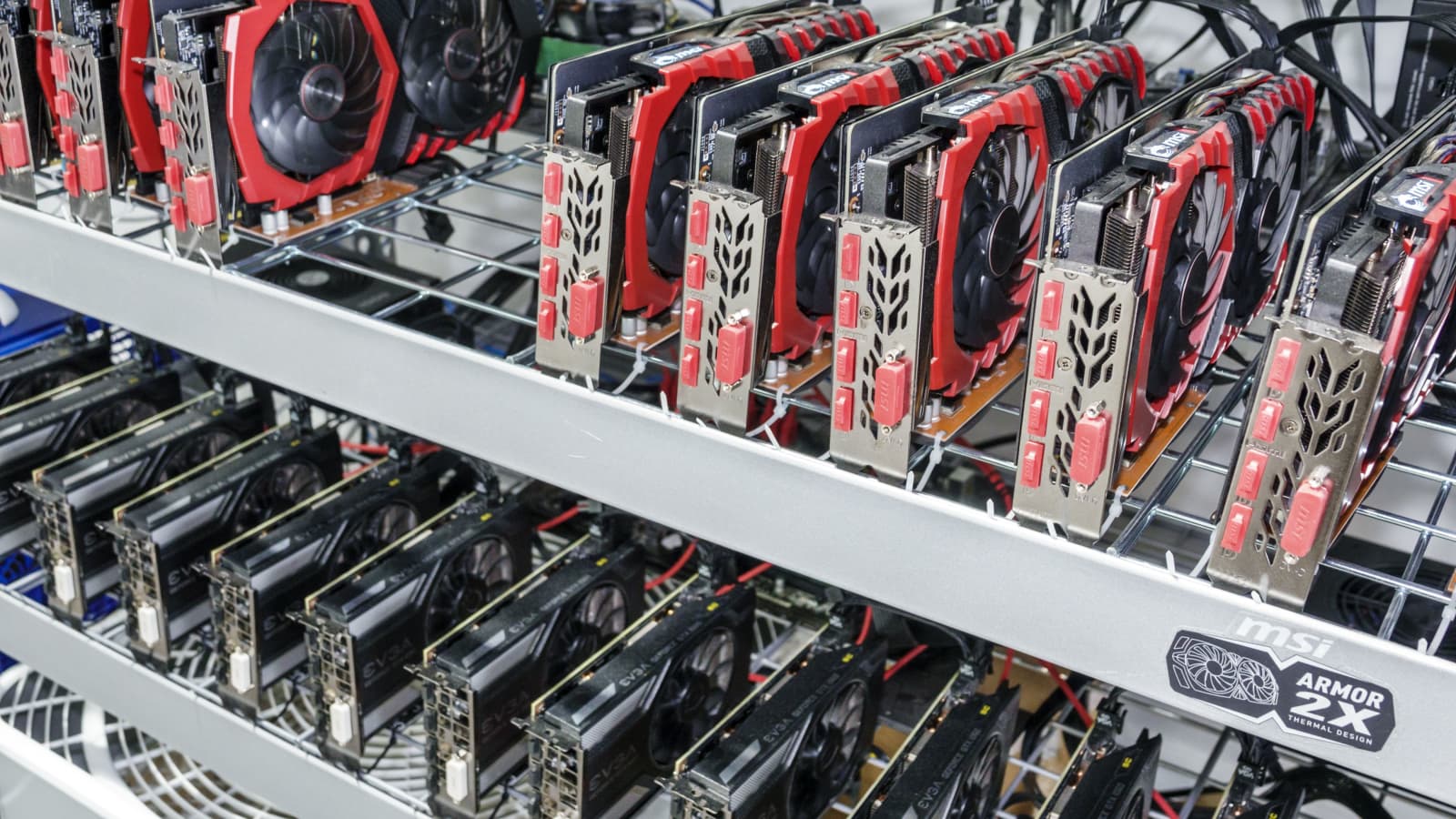Introduction
Cryptocurrency mining has become a popular and potentially lucrative endeavor for individuals looking to capitalize on the booming digital currency market. With the rise in popularity of cryptocurrencies like Bitcoin, Ethereum, and Litecoin, mining has emerged as a way to earn these digital assets by verifying transactions and adding them to the blockchain.
But how much can you really make from crypto mining? The answer to this question depends on several factors, including the type of cryptocurrency being mined, the hardware and software used, electricity costs, and the current market conditions. It’s important to have a clear understanding of these variables before diving into the world of mining.
In this article, we will provide an overview of crypto mining, discuss the factors that affect profitability, explore the different types of cryptocurrencies available for mining, outline the hardware and software requirements, explain mining pools and solo mining, delve into calculating potential earnings, analyze the impact of electricity costs on revenue, highlight the risks and challenges involved in mining, and touch upon the tax implications of mining income.
Whether you’re a beginner looking to dip your toes into the mining world or an experienced miner looking to optimize your earnings, this comprehensive guide will equip you with the knowledge you need to navigate the world of crypto mining and make informed decisions about the potential profitability.
Overview of Crypto Mining
Crypto mining, also known as cryptocurrency mining or Bitcoin mining, is the process of validating transactions and adding them to the blockchain, the decentralized ledger that records all cryptocurrency transactions. Miners use powerful computers to solve complex mathematical problems that verify the authenticity of transactions and create new blocks in the blockchain.
The mining process relies on a consensus algorithm, which varies depending on the type of cryptocurrency. The most common algorithm is proof of work (PoW), where miners compete to find the correct solution to the mathematical problem. Once a solution is found, the miner broadcasts it to the network, and if it is valid, the block is added to the blockchain, and the miner is rewarded with new coins.
One of the key aspects of crypto mining is the concept of difficulty. Difficulty is a measure of how hard it is to find a valid solution to the mathematical problem. It adjusts automatically based on the network’s computational power to ensure that blocks are added to the blockchain at a consistent rate. As more miners join the network, the difficulty increases, making it more challenging to mine new coins.
It’s important to note that not all cryptocurrencies can be mined. Some, like Bitcoin, have a limited supply, and mining is the only way to obtain new coins. Others, like Ripple, have a pre-mined supply, meaning all coins were created and distributed before the launch. However, even for pre-mined cryptocurrencies, mining still plays a crucial role in maintaining the network’s security and consensus.
Overall, crypto mining is a competitive and resource-intensive process. It requires specialized hardware, such as ASIC (Application-Specific Integrated Circuit) miners for Bitcoin, and a significant amount of electricity to power the mining rigs. While the rewards can be substantial, it’s important to consider the costs and factors that affect profitability before embarking on a mining venture.
Factors Affecting Mining Profitability
When it comes to crypto mining, profitability is influenced by a variety of factors. Understanding these factors is crucial for miners to maximize their earnings and make informed decisions. Here are some key factors that can significantly impact mining profitability:
By considering these factors and conducting thorough research, miners can make informed decisions to optimize profitability. It’s important to regularly assess the market conditions and adjust mining strategies accordingly to stay ahead in this highly competitive industry.
Types of Cryptocurrencies to Mine
When it comes to cryptocurrency mining, there is a wide range of options available. While Bitcoin is the most well-known and widely mined cryptocurrency, there are plenty of other altcoins that offer mining opportunities. Here are some popular types of cryptocurrencies that can be mined:
1. Bitcoin (BTC): As the first and most famous cryptocurrency, Bitcoin is often the go-to choice for miners. However, mining Bitcoin has become highly competitive due to the high computing power required and the specialized ASIC miners that dominate the network. It may be more challenging for individual miners to achieve profitability with Bitcoin mining unless they have access to low-cost electricity and the latest mining equipment.
2. Ethereum (ETH): Ethereum is the second-largest cryptocurrency by market capitalization and offers mining opportunities through a consensus algorithm called Ethash. It is more accessible to individual miners compared to Bitcoin, as it can be mined with consumer-grade GPUs (Graphics Processing Units). However, Ethereum is planning to transition to a new consensus algorithm called Proof of Stake (PoS) in the future, which will replace mining with staking.
3. Litecoin (LTC): Created by Charlie Lee, a former Google engineer, Litecoin is often referred to as the silver to Bitcoin’s gold. It was designed to offer faster transaction confirmation times and a different hashing algorithm called Scrypt. Litecoin mining can be done with both ASIC miners and GPUs, making it more accessible to a wider range of miners.
4. Monero (XMR): Monero is a privacy-focused cryptocurrency that offers enhanced anonymity features. It utilizes a consensus algorithm called CryptoNight, which is designed to be resistant to ASIC mining. This means that miners can use consumer-grade CPUs and GPUs to mine Monero, making it more accessible for individual miners.
5. Zcash (ZEC): Zcash is another privacy-focused cryptocurrency that offers secure and private transactions. It uses a consensus algorithm called Equihash, which is also ASIC-resistant. This allows for GPU mining, making it more accessible to individual miners without specialized hardware.
6. Dash (DASH): Dash, which stands for Digital Cash, aims to provide fast and private transactions. It uses a hybrid consensus algorithm that combines elements of both Proof of Work (PoW) and Proof of Stake (PoS). Dash mining can be done with ASIC miners, but it also offers Masternode staking opportunities for additional rewards.
These are just a few examples of the types of cryptocurrencies that can be mined. It’s important for miners to do their research and consider factors such as network difficulty, block rewards, and market demand when choosing which cryptocurrencies to mine. Additionally, staying updated with the latest developments in the cryptocurrency space can help identify emerging opportunities for mining.
Hardware and Software Requirements
Successful cryptocurrency mining requires the right combination of hardware and software. Having the appropriate equipment and software setup is essential for maximizing mining efficiency and profitability. Let’s explore the hardware and software requirements for crypto mining:
1. Mining Hardware: The most important piece of equipment for mining is the mining rig. The specific hardware requirements vary depending on the cryptocurrency being mined. For example, Bitcoin mining requires specialized ASIC (Application-Specific Integrated Circuit) miners, while other cryptocurrencies like Ethereum can be mined with consumer-grade CPUs or GPUs. Miners should choose mining hardware that offers high hash rates and energy efficiency to maximize profitability.
2. Graphics Processing Units (GPUs): GPUs are commonly used for mining certain cryptocurrencies, such as Ethereum. They are particularly effective at solving complex mathematical calculations required for mining. Miners may opt to build a rig with multiple GPUs to increase their mining capabilities and improve profitability.
3. Central Processing Units (CPUs): While CPUs are generally less efficient than GPUs for mining, some cryptocurrencies, like Monero, can still be effectively mined using CPU power. Miners with access to powerful CPUs may choose to mine CPU-friendly cryptocurrencies to take advantage of their processing capabilities.
4. Mining Software: Mining software is essential for connecting the mining hardware to the blockchain network and managing the mining process. There are various mining software options available, including popular choices like CGMiner, BFGMiner, and EasyMiner. These software tools provide features such as monitoring and controlling mining operations, tracking mining statistics, and configuring mining settings.
5. Wallet: Every miner needs a cryptocurrency wallet to securely store their mined coins. A wallet is a digital storage space that holds the miner’s private keys, allowing them to send, receive, and store cryptocurrencies. There are different types of wallets, including online wallets, hardware wallets, and software wallets. It’s crucial to choose a wallet that offers a high level of security and convenience.
6. Internet Connection: A stable and reliable internet connection is essential for crypto mining. Miners need to stay connected to the blockchain network to receive and validate transactions. A slow or unreliable internet connection can lead to mining disruptions and potential loss of earnings.
7. Cooling System: Mining rigs generate a significant amount of heat during the mining process. It’s vital to have a proper cooling system in place to prevent overheating and ensure the longevity of the hardware. This can be achieved through the use of cooling fans, liquid cooling systems, or dedicated mining rig frames with built-in ventilation.
By investing in the right hardware and software and ensuring proper cooling and internet connectivity, miners can create an optimized mining setup that maximizes their chances of profitability. It’s important to regularly update and maintain mining equipment and software to stay competitive in the constantly evolving world of cryptocurrency mining.
Mining Pools and Solo Mining
When it comes to cryptocurrency mining, miners have the option to either join mining pools or engage in solo mining. Each approach has its own advantages and considerations. Let’s take a closer look at mining pools and solo mining:
Mining Pools: Mining pools are groups of miners who come together to combine their resources and increase their chances of mining new blocks. By pooling their computing power, miners can collectively solve complex mathematical problems more efficiently and generate a more steady income. When a mining pool successfully mines a new block, the rewards are distributed among the pool members based on their contributed hash power. This method is ideal for small-scale miners or miners with limited resources, as it offers a more consistent income stream compared to solo mining. Additionally, mining pools often provide helpful features like mining software and statistics tracking.
Solo Mining: Solo mining, on the other hand, involves mining on an individual basis without joining a mining pool. In this approach, the miner relies solely on their own computing power to mine new blocks. If the miner is successful in discovering a new block, they receive the full block reward. Solo mining can be more profitable if the miner has access to high computational power, has low mining difficulty, or is mining a relatively new and undervalued cryptocurrency. However, solo mining carries higher risks, as finding a new block can take a significant amount of time, especially for popular cryptocurrencies with high network difficulty. Miners must weigh the potential for higher rewards against the possibility of long periods without earning any income.
Choosing between mining pools and solo mining depends on various factors such as the miner’s computational power, the cryptocurrency being mined, network difficulty, and individual risk tolerance. For beginners or miners with limited resources, joining a mining pool is often recommended as it provides a more predictable income stream. As miners gain more experience and acquire more powerful mining equipment, they may choose to explore solo mining to have more control over their mining operations and potentially earn higher rewards.
It’s important for miners to thoroughly research and evaluate different mining pools before joining. Factors to consider include the pool’s reputation, fee structure, payment methods, and the size and activity of the pool. By actively participating in a mining community and staying updated on mining trends and developments, miners can make informed decisions and optimize their mining strategies.
Calculating Potential Earnings
Calculating potential earnings is a crucial step for miners to assess the profitability of their mining operations. While the exact calculation will vary depending on the cryptocurrency being mined and the specific mining setup, there are some key factors to consider when estimating potential earnings:
By considering these factors and utilizing online mining calculators, miners can estimate their potential earnings. These calculators take into account variables such as hash rate, network difficulty, electricity costs, and block reward to provide an approximation of the expected earnings over a given period. It’s important to note that these calculations are estimates and real-world earnings may vary due to unpredictable factors such as mining pool luck, hardware failure, or changes in the cryptocurrency market.
Regularly reviewing and updating the calculations based on changing market conditions and mining parameters will help miners make informed decisions and optimize their mining operations for maximum profitability.
Electricity Costs and Revenue Analysis
Electricity costs are a significant factor that can greatly impact the profitability of cryptocurrency mining. Mining rigs consume a substantial amount of electricity, and miners need to carefully analyze their electricity costs in relation to their potential earnings. Here is an overview of how electricity costs can affect revenue in cryptocurrency mining:
It is crucial for miners to perform regular reviews of their electricity costs and revenue analysis to adapt to fluctuations in electricity rates and cryptocurrency market conditions. By closely monitoring expenses and optimizing energy efficiency, miners can enhance their profitability in the competitive world of cryptocurrency mining.
Risks and Challenges in Crypto Mining
While crypto mining can be potentially profitable, it is also associated with several risks and challenges that miners need to be aware of. Understanding these risks is essential for miners to mitigate potential losses and navigate the volatile cryptocurrency market effectively. Here are some of the key risks and challenges in crypto mining:
Overall, crypto mining involves inherent risks and challenges. Miners should carefully weigh the potential rewards against these risks and regularly monitor market conditions to make informed decisions. By staying informed, adapting to changes, and actively managing risks, miners can position themselves for long-term success in the crypto mining industry.
Tax Implications of Mining Income
One aspect of crypto mining that miners need to consider is the tax implications of their mining income. As cryptocurrencies are still relatively new, tax regulations surrounding mining activities can vary from country to country. Here are some key points to understand about the tax implications of mining income:
1. Taxable Event: In most jurisdictions, mining is considered a taxable event. This means that miners are typically required to report and pay taxes on the value of the mined cryptocurrencies as income, regardless of whether the mined coins are converted into fiat currency or held as investments.
2. Income Tax or Capital Gains Tax: The tax treatment of mining income can vary depending on the classification of the income. In some countries, mining income is treated as ordinary income and taxed at the applicable income tax rates. In others, it may be considered capital gains if the mined coins are held as investments. Miners should consult with a tax professional or research the specific tax laws in their jurisdiction to determine how mining income is classified and taxed.
3. Value of Mined Cryptocurrency: Determining the value of mined cryptocurrencies for tax purposes can be challenging, especially given the volatility of crypto markets. Miners may need to rely on the fair market value of the coins at the time they are mined or use a consistent valuation method approved by the tax authorities.
4. Deductible Expenses: Miners may be eligible to deduct certain expenses related to their mining activities. These expenses could include costs associated with purchasing mining equipment, electricity costs, mining software subscriptions, and maintenance expenses. However, the deductibility of these expenses can vary depending on the tax laws of each jurisdiction.
5. Record-Keeping Requirements: To accurately report mining income and claim any eligible deductions, miners should maintain detailed records of their mining activities. This includes documentation of mining receipts, equipment purchases, electricity bills, and transaction history. Keeping thorough records will not only simplify tax reporting but also serve as evidence in case of any tax audits.
6. Reporting Obligations: Miners are obligated to report their mining income and fulfil their tax obligations according to the laws of their respective jurisdictions. Failure to report mining income could result in penalties, fines, or other legal consequences. Miners should consult with a tax advisor or seek guidance from local tax authorities to ensure compliance with tax laws.
7. International Tax Considerations: For miners operating across international borders, there may be additional tax implications to consider, such as double taxation treaties, foreign tax credits, and reporting requirements in multiple jurisdictions. Consulting with a tax professional who specializes in international taxation can help navigate these complex issues.
It is vital for miners to be proactive in understanding and fulfilling their tax obligations to avoid any legal complications. Seeking advice from a qualified tax professional who is familiar with cryptocurrency taxation can provide miners with the necessary guidance and ensure compliance with tax laws specific to their situation and jurisdiction.
Conclusion
Crypto mining can be an exciting and potentially profitable endeavor for individuals looking to participate in the world of cryptocurrencies. However, it is essential to approach mining with a thorough understanding of the various factors that can affect profitability. By considering the overview of crypto mining, the factors that impact mining profitability, the types of cryptocurrencies to mine, the hardware and software requirements, mining pools versus solo mining, calculating potential earnings, electricity costs, and the tax implications of mining income, miners can make informed decisions and optimize their mining operations.
It is crucial for miners to stay updated with the latest developments in the crypto mining industry, including changes in mining algorithms, regulatory updates, and market trends. Regularly reviewing and adapting mining strategies based on these developments can help miners stay competitive and maximize their potential earnings.
Additionally, miners should exercise caution and manage the risks involved in crypto mining. Market volatility, increased network difficulty, hardware and maintenance costs, electricity costs, technological advancements, and security threats are among the risks and challenges that miners need to navigate. By staying informed, implementing proper security measures, and actively managing risks, miners can minimize potential losses and enhance their profitability.
Lastly, miners must be aware of the tax implications of their mining income and fulfill their tax obligations according to the laws of their jurisdiction. Consulting with a tax professional who specializes in cryptocurrency taxation is advisable to ensure compliance and avoid legal complications.
In conclusion, crypto mining offers exciting opportunities for individuals to participate in the growing world of cryptocurrencies. By understanding the various aspects of mining, considering the risks and challenges, and staying informed about the latest developments in the industry, miners can position themselves for success in this dynamic and potentially rewarding field.

























